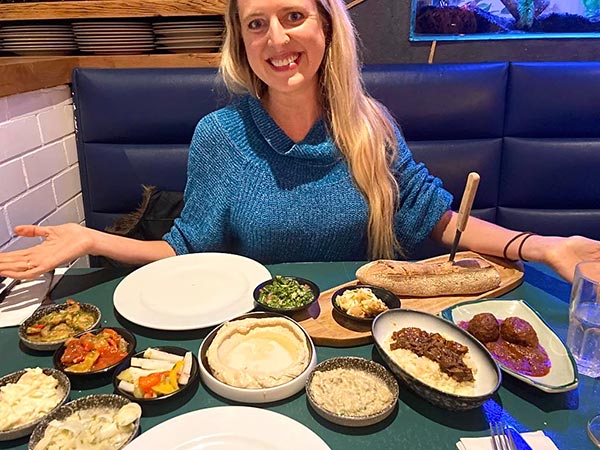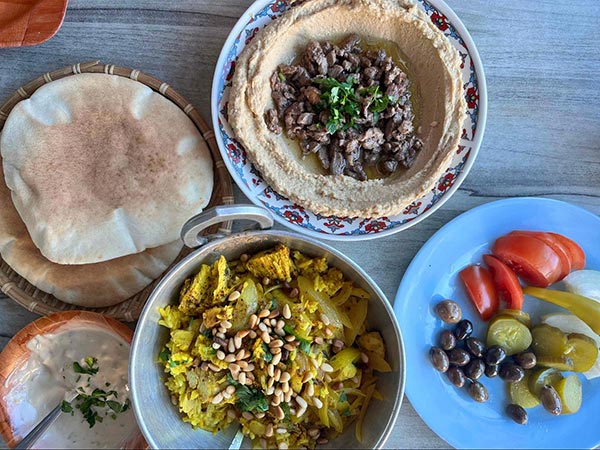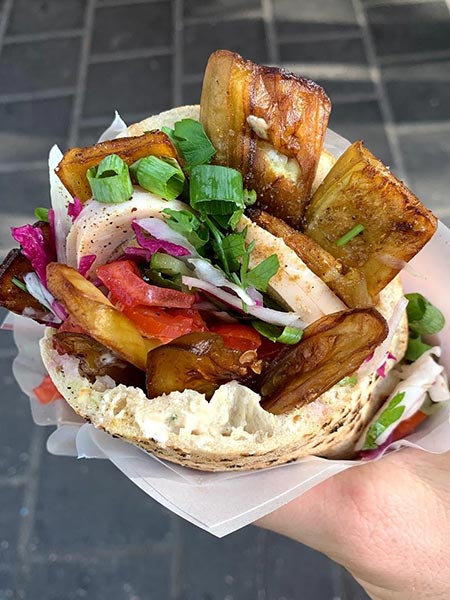The Fantastic Flavors of Israel
Sophie Lippert, concert pianist and All Classical Portland’s 2022 International Arts Correspondent, is currently living in Tel Aviv, Israel. In this edition of Musician Abroad!, she takes us on a journey through Tel Aviv’s culinary landscape, showcasing savory and sweet delicacies and delights.

Food has always been one of my favorite ways to connect with a culture. It’s an amazing miracle for me to take a “sensory trip” to experience the essence of a place by sipping a cup of steaming soup, eating a bowl of aromatic noodles, or devouring a delicious dessert.
I find music and food to be strikingly similar in the way they allow us to travel (with our senses) to different places, and connect with the flavors or sounds of a foreign country and culture without getting on a plane.
Transcending, Connecting, and Traveling through Taste and Sound
I notice food’s resemblance to music in several noteworthy ways:
- They both serve as conduits of connection, and transcend language boundaries.
- They both are vehicles for bringing people together in community.
- They both give us a chance to experience a culture outside of its particular geographical location; a vantage point into the sensory experience of a place, without physically being in country.
These are part of music and food’s “special sauce,” and part of what makes them so priceless and precious.

There were many times during the pandemic when I longed to expand my cultural horizons, but was stuck at home in Portland. The thing that helped me most was to either listen to—or play!—music from a different country, or cook a meal that utilized and showcased foreign flavors and ingredients. Listening to infectious rhythms from Senegal, Africa, or cooking an Indian recipe that utilizes freshly-ground cardamom pods and coriander seeds, might not be quite the same as traveling to Senegal or India—but it creates a great sensory experience, and allows me to travel—in my senses, at least—somewhere outside of my own home.
(One of my favorite things to do is to pair the music I’m listening to with the type of cuisine I’m eating! So, if I’m cooking a Chinese-inspired dish, I’ll find some traditional Chinese music to listen to. What a great way to expand my horizons.)
Given the strong parallels in my life between food and music, it feels only appropriate to spend some time profiling Israel’s amazing cuisine / culinary landscape!
A Melting Pot of Flavors
The Mediterranean Sea runs the western length of Israel’s border, and because of this, it’s no surprise that the primary flavors here pull from Mediterranean cuisine. Street stalls are filled with pungent olive oils and rich dates and nuts; dairy stands sport dozens of varieties of feta cheese; cucumbers and tomatoes are paired with parsley to form the nation’s famous “Israeli salad.” Alongside this, however, there’s a decidedly Middle Eastern flare that also plays into the richness of Israel’s culinary landscape. Spices like cumin and coriander are used liberally in many applications; the quintessential “Za’atar” (a mix of sesame seeds, sumac, salt, and herbs like thyme, oregano, and marjoram) tops bowls of creamy hummus and soft breads and savory pastries; kebab meat makes an appearance at nearly every Israeli restaurant. And then, with the prevalence of Judaism comes an abundance of kosher and other religiously-influenced food products: beef-based sausages and deli meats abound (it’s rare to find pork on a menu!), special sweets make appearances for the Jewish holidays, and challah is baked fresh at all the bakeries in time for Friday’s sabbath dinner. Much like many aspects of Israeli culture, I find the food here to be an amazing melting pot of different traditions; heavily influenced by the many different cultures and people who have lived in this region over the centuries.

There are three main areas I’m excited to showcase: the pita (what I might call Israel’s signature dish); the love of salads (and the first thing we need to do is define that term, as it’s different than what you might expect!); and a run-down of the country’s favorite sweets.
Meals in a Pita
Israelis love their pitas. And, for good reason! Color me biased, but I’d like to boldly state that until you’ve tasted a pita from the Middle East, you’ve never gotten a full experience of the incredible art form that is this beloved pocket bread.
Yep: I’m just talking about the pita itself—even before it’s filled with all sorts of tasty treats! The Israeli pita tells a complex and intoxicating story. It features a fluffiness, lightness, and buoyancy; the flavor is mild, the texture is rich, and the combination creates a taste that’s irresistible in nearly every iteration. And how something so intoxicatingly airy manages to be hefty enough to be stuffed to the gills with vegetables and meats is beyond me.
Another delight: for anyone who doesn’t eat gluten, many restaurants carry gluten-free pitas that are just as delicious as their glutinous counterparts!
The pita is rarely just eaten on its own, though. Its simplest application is perhaps dipped in bowls of hummus, and served alongside slices of raw white onion, tomato, and pickles. (Hummus restaurants can be found on nearly every street corner in Israel, and deserve a whole post in themselves!)

The pita is also the centerpiece of nearly every street food here. The most common three are the following:
- Shawarma. This tasty shaved meat is cooked on a giant rotisserie or spit. It’s a pretty dramatic endeavor: the meat is shaved thin and then shaped into a huge cone, then shaved off in a circular fashion. It’s almost always served in a pita with a variety of accouterements: tahini-garlic sauce, pickles, diced tomatoes, cucumbers, and onions, and some other variety of pickled vegetables and cabbage slaws. There’s another sauce, which is mango-based and a bit spicy and sweet, which is also common as a final topping. And french fries on the side are optional, but very much suggested.
- Falafel. I’ve had plenty of falafel in my life, but much like my experience with pita, until coming to Israel I never realized the extent of complexity and deliciousness that could be contained within these little fried balls made primarily of ground garbanzo beans. Generally smelling and tasting faintly of parsley, garlic, scallions, and cumin, these fritters are most commonly deep fried, then stuffed into a pita with a similar assortment of accompaniments to the shawarma: raw and pickled vegetables, and then sauces on top: tahini, and an amazingly herbaceous spicy green sauce (a little packs a real punch!). Our favorite local falafel joint layers the ingredients so beautifully that the finished product truly DOES look like a piece of art—and tastes like one, too. Unbelievable.
- Sabich. Perhaps less known globally, this trendy street food is wildly popular in Israel. Apparently it originated in the 1940s and 1950s as a simple breakfast, using the easiest ingredients on hand: leftover eggplant, hard-boiled eggs, and maybe potatoes for kicks. Now, it’s become a competitive phenomenon: the debate rages around Tel Aviv as to which sabich shop executes their sabich with the most craft and finesse. The centerpiece of a sabich is the crispy fried slabs of eggplant—which, in the hands of a skilled cook, are even incredible eaten alone: oily and crispy exterior, soft and almost sweet interior. In a sabich sandwich, however, they’re paired with eggs, that Israeli holy trinity (tomatoes, cucumber, onion), parsley, and—you guessed it—tahini to top everything off. Though sabich is tasty at any time of day, it’s still most common as a breakfast or lunch dish; in fact, like falafel, most joints close by 4 or 5pm.



Now that we’ve explored pita in its many iterations, let’s take a left turn to another quintessential feature of the Israeli dining scene: salads.
All The Salads

Breakfast, lunch, or dinner. So many veggies!
First, it’s important to define what “salad” means in this context. Upon first arriving in Israel, I was surprised to find that salads seemed like an “all-inclusive” experience here— A spread of Israeli salads consists, essentially, of anything cold that can be served in a small dish as an appetizer.
When dining at a traditional Israeli restaurant, get ready: you’re in for all sorts of treats beyond those that you order. It’s still typical to order an entree per person (in Tel Aviv, that’s almost always a cut of meat or fish); however, before you receive your chosen dish, you’ll be bombarded with a smorgasbord of incredible small dishes—which fill the center of table with festive colors and textures. Sometimes, there are up to TWO DOZEN different options to nibble on.
Some of the offerings often found in an Israeli “salad” spread are as follows:
- Hummus
- Baba ganoush
- Thinly-sliced ribbons of cabbage with dill in a mild vinegar dressing
- Greens with chunky tomatoes, crumbled goat cheese, sumac, and lemon
- Fried eggplant
- Roasted cauliflower
- Shredded carrots with candied walnuts
- Chunky roasted beets with parsley
- Parsley-heavy tabbouleh salad
- Cucumbers with onion
- Lightly-steamed corn kernels with red peppers and spices
- Tuna salad
- Pasta salad
- Pickled jalapenos or pepperoncini peppers
- Saucy tomatoes
- Shaved fennel
…and the list goes on!

Sophie’s mother and father-in-law are all smiles before diving in to their salad course in a sunny, beachside Jaffa restaurant.
Pita is always served as an accompaniment, and sometimes, there’s another baked bread covered with melted cheese, or olive oil and za’atar, or chunky roasted garlic.
There’s something for everyone—and, if you’re like me, nearly everything is finger-licking good!
That said, I wish that salads came with a warning, as I’ve had to learn the hard way to pace myself. The small plates are generally refilled numerous times during the meal, so it’s easy to get completely full on the vegetables even before a main course has arrived!
In fact, my husband Noah and I have occasionally opted to order ONLY the salads for our main meal. Usually a restaurant charges a fee of about 35-40 shekels per person—about $12—but it’s unquestionably the best deal in town!

Salads on their own can serve as a perfectly satisfying and delicious meal in Tel Aviv. Despite the absence of a “main course,” Sophie and her husband Noah were stuffed after this filling feast!
Another difference: salads are served and eaten at any time of day. Yep: even breakfast! In fact, a traditional Israeli breakfast spread consists of bread or pastries, and perhaps a side of eggs—and then, an array of all those amazing aforementioned vegetable dishes.
But, enough of savory—let’s turn now to the treats!
Make Way for Sweets!
- Sweets: different sub-categories, but “local desserts” (not European-style cafes or bakeries) are commonly nut and honey-based, and often a sweet crunchy semolina noodle is used. Also: LOVE OF ICE CREAM.
- Fruit: tropics! In-season is key; the fruit at the market changes dramatically depending on time of year & what’s available. Watermelon, grapes, plums, mangos, FIGS. Always: citrus of all types, avocados (though different varieties pop up at different times!), bananas (huge banana groves in Eastern Israel!),
- Drinks: soda is much more common here than in the United States! Also, the types of varieties of sugary drinks at any given convenience store is pretty damn impressive. (Twix in a bottle? Guava puree? Sparkling fruity mixers? You name ‘em, they’ve got ‘em.)
SWEETS.
Honey-based.
Candy.
International.
Ice cream.




Even More Diversity of Deliciousness
Before I wrap today, I want to be clear: this is a non-comprehensive foray into Israeli food. There are so many different culinary experiences that can be had in Tel Aviv—it is a huge international city, and offers an impressive array of different flavors and types of food! I neglected to include a few particular enticing local treats: Jachnun, burekas (basically, dough stuffed with any array of savory things), and the food and drinks that accompany the Israeli love of what I’d call “cafe culture” (long hours spent leisurely sitting, sipping, and supping). There are also some very interesting “fusion”-dining experiences here—you wouldn’t believe what they manage to fit in sushi rolls! (Yep, that includes shawarma meat!) There’s so much diversity and deliciousness to experience here!

An exploration of Tel Aviv wouldn’t be complete without mention of the beautiful spices, too—an enticing array of flavors and aromas that waft from spice shops across any of the local street markets. And though other ethnic foods can be hard to find, there are a few great restaurants that showcase foods from different parts of the world: Mexican tacos, Thai curries, Chinese dim sum, Indian thalis. There’s even excellent Ethiopian food, served on spongy injera and eaten with no utensils!

[And Yahweh knows I could wax poetic on hummus alone—the shining centerpiece of Middle Eastern food—for many more hundreds of words.]
If there’s one thing I’ve learned and confirmed about Israeli food while being here, it’s that there’s a tremendous pride and art and joy that it contains and instills. People here are voracious, joyful eaters; food serves as a conduit for community and connection, and a centerpiece for celebration and ceremony. I’ll miss these dazzling tastes when I return to the United States—but hopefully, will find opportunity to travel back to Israel through my senses over salads for breakfast, pitas stuffed with fried eggplant or falafel for lunch, bowls of silky hummus for snacks, and pistachio-studded baklava for desserts.
And I’ll never stop being grateful for the way that music and food both serve as conduits of connection and togetherness! Listening to music, and having a meal filled with delicious food, are equal-opportunity experiences; both allow people of all different backgrounds, cultures, languages, physical and mental capabilities, and socioeconomic statuses to connect and share experiences. And what a gift to share sounds and flavors with people around the world.
Wishing you all experiences with meals and music that transport you outside of your normal sensory stomping grounds!
Stay tuned for the final blog in Sophie’s Musician Abroad! series coming this winter! You can also learn more about Sophie at sophielippert.com.




